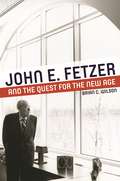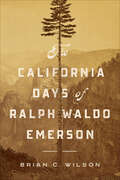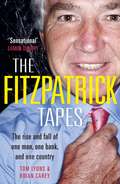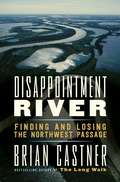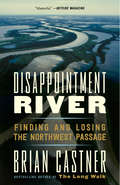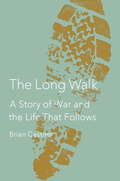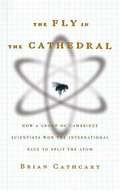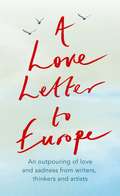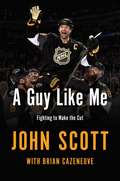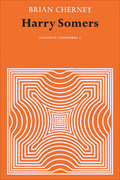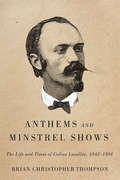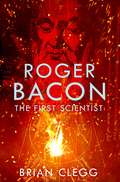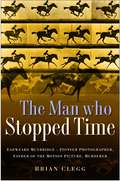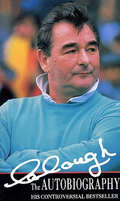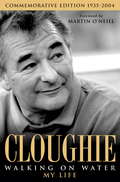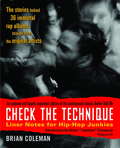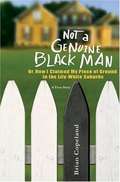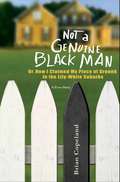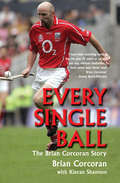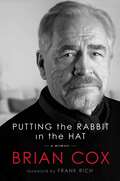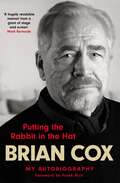- Table View
- List View
John E. Fetzer and the Quest for the New Age (Great Lakes Books Series)
by Brian C. WilsonJohn E. Fetzer and the Quest for the New Age follows the spiritual sojourn of John E. Fetzer, a Michigan business tycoon. Born in 1901 and living most of his life in Kalamazoo, Fetzer parlayed his first radio station into extensive holdings in broadcasting and other enterprises, leading to his sole ownership of the Detroit Tigers in 1961. By the time he died in 1991, Fetzer had been listed in Forbes magazine as one of the four hundred wealthiest people in America. And yet, business success was never enough for Fetzer—his deep spiritual yearnings led him from the Christianity of his youth to a restless exploration of metaphysical religions and movements ranging from Spiritualism, Theosophy, Freemasonry, UFOology, and parapsychology, all the way to the New Age as it blossomed in the 1980s. Author Brian C. Wilson demonstrates how Fetzer’s quest mirrored those of thousands of Americans who sought new ways of thinking and being in the ever-changing spiritual movements of the twentieth century. Over his lifetime, Fetzer's worldview continuously evolved, combining and recombining elements from dozens of traditions in a process he called "freedom of the spirit." Unlike most others who engaged in a similar process, Fetzer’s synthesis can be documented step by step using extensive archival materials, providing readers with a remarkably rich and detailed roadmap through metaphysical America. The book also documents how Fetzer’s wealth allowed him to institutionalize his spiritual vision into a thriving foundation—the Fetzer Institute—which was designed to carry his insights into the future in hopes that it would help catalyze a global spiritual transformation. John E. Fetzer and the Quest for the New Age offers a window into the rich and complex history of metaphysical religions in the Midwest and the United States at large. It will be read with interest by those wishing to learn more about this enigmatic Michigan figure, as well as those looking for an engaging introduction into America’s rapidly shifting spiritual landscape.
The California Days of Ralph Waldo Emerson
by Brian C. Wilson“A vivid and painstakingly researched account of Emerson’s late-in-life, seven-week trek across the North American continent in 1871.” —New York Review of BooksIn the spring of 1871, Ralph Waldo Emerson boarded a train in Concord, Massachusetts, bound for a month-and-a-half-long tour of California—an interlude that became one of the highlights of his life. On their journey across the American West, he and his companions would take in breathtaking vistas in the Rockies and along the Pacific Coast, speak with a young John Muir in the Yosemite Valley, stop off in Salt Lake City for a meeting with Brigham Young, and encounter a diversity of communities and cultures that would challenge their Yankee prejudices.Based on original research employing newly discovered documents, The California Days of Ralph Waldo Emerson maps the public story of this group’s travels onto the private story of Emerson’s final years, as aphasia set in and increasingly robbed him of his words. Engaging and compelling, this travelogue makes it clear that Emerson was still capable of wonder, surprise, and friendship, debunking the presumed darkness of his last decade.“Wilson effectively conveys Emerson’s cultural myopia, along with its late-Victorian context.” —Times Literary Supplement“Deeply researched, enjoyably readable.” —San Francisco Chronicle“What Wilson offers the Emersonian reader today is a unique story of Emerson in motion, having a particularly American experience in looking westward.” —Emerson Society Papers“A welcome addition to Emerson scholarship and the first comprehensive treatment of his journey westward to the Pacific state.” —Ronald A. Bosco, general editor of The Collected Works of Ralph Waldo Emerson
The FitzPatrick Tapes: The Rise and Fall of One Man, One Bank, and One Country
by Tom Lyons Brian CareyThe FitzPatrick Tapes: The sensational story of the man and the bank that brought Ireland lowOne day in May 2009, Sean FitzPatrick - the disgraced former chief executive and chairman of Anglo Irish Bank - sat down to lunch in a Holiday Inn in Dublin. Across the table sat Tom Lyons, a business reporter with the Sunday Times. Seven months later, the two met for the first of what would be seventeen formal, tape-recorded interviews over the course of 2010: a year when Ireland, its public finances ruined in large part by the cost of covering Anglo's losses, went bust itself. In these interviews, FitzPatrick talked at length and in detail about his banking experiences and philosophy, his colleagues and clients, his investments, his public disgrace, his arrest and his bankruptcy.Lyons and his colleague Brian Carey draw on the FitzPatrick tapes and on their many sources within Anglo, the state and the business community to tell the story of that crisis - and of the man who became the face of it. This is a tale of toothless regulators, hopeless accountants, politicians and civil servants out of their depth, and businessmen in denial about the crash. Above all, though, it is the story of FitzPatrick: the man who built that bank that has been at the centre of Ireland's economic meltdown.'A sensational document' Eamon Dunphy, Newstalk'It is a journalistic scoop; the story of a bank that got too big; a snapshot of an economic era; and, already, a piece - or at least a version - of history' Sunday Business Post
Disappointment River: Finding and Losing the Northwest Passage
by Brian CastnerIn 1789, Alexander Mackenzie travelled the 1,125 miles of the immense river in Canada that now bears his name, in search of the fabled Northwest Passage. In 2016, the acclaimed memoirist Brian Castner retraced Mackenzie's route by canoe in a grueling journey—in search of Mackenzie's Passage 200 years later.Disappointment River is a dual historical narrative and travel memoir that at once transports readers back to the heroic age of North American exploration and places them in a still rugged but increasingly fragile Arctic wilderness in the process of profound alteration by the dual forces of energy extraction and climate change. Fourteen years before Lewis and Clark, Mackenzie set off to cross the continent of North America with a team of voyageurs and Chipewyan guides. In this book, Brian Castner not only retells the story of Mackenzie's epic voyages in vivid prose, he personally retraces his travels in an 1,125-mile canoe voyage down the river that bears his name, battling exhaustion, exposure, mosquitoes, white water rapids and the threat of bears. He transports readers to a world rarely glimpsed in the media, of tar sands, thawing permafrost, remote indigenous villages and, at the end, a wide open Arctic Ocean that has the potential of becoming a far-northern Mississippi of barges and pipelines and oil money.
Disappointment River: Finding and Losing the Northwest Passage
by Brian CastnerIn 1789, Alexander Mackenzie traveled 1200 miles on the immense river in Canada that now bears his name, in search of the fabled Northwest Passage that had eluded mariners for hundreds of years. In 2016, the acclaimed memoirist Brian Castner retraced Mackenzie's route by canoe in a grueling journey -- and discovered the Passage he could not find. Disappointment River is a dual historical narrative and travel memoir that at once transports readers back to the heroic age of North American exploration and places them in a still rugged but increasingly fragile Arctic wilderness in the process of profound alteration by the dual forces of globalization and climate change. Fourteen years before Lewis and Clark, Mackenzie set off to cross the continent of North America with a team of voyageurs and Chipewyan guides, to find a trade route to the riches of the East. What he found was a river that he named "Disappointment." Mackenzie died thinking he had failed. He was wrong. In this book, Brian Castner not only retells the story of Mackenzie's epic voyages in vivid prose, he personally retraces his travels, battling exhaustion, exposure, mosquitoes, white water rapids and the threat of bears. He transports readers to a world rarely glimpsed in the media, of tar sands, thawing permafrost, remote indigenous villages and, at the end, a wide open Arctic Ocean that could become a far-northern Mississippi of barges and pipelines and oil money.
The Long Walk: A Story of War and the Life That Follows
by Brian CastnerIn the tradition of Michael Herr's Dispatches and works by such masters of the memoir as Mary Karr and Tobias Wolff, a powerful account of war and homecoming.Brian Castner served three tours of duty in the Middle East, two of them as the commander of an Explosive Ordnance Disposal unit in Iraq. Days and nights he and his team--his brothers--would venture forth in heavily armed convoys from their Forward Operating Base to engage in the nerve-racking yet strangely exhilarating work of either disarming the deadly improvised explosive devices that had been discovered, or picking up the pieces when the alert came too late. They relied on an army of remote-controlled cameras and robots, but if that technology failed, a technician would have to don the eighty-pound Kevlar suit, take the Long Walk up to the bomb, and disarm it by hand. This lethal game of cat and mouse was, and continues to be, the real war within America's wars in Iraq and Afghanistan. But The Long Walk is not just about battle itself. It is also an unflinching portrayal of the toll war exacts on the men and women who are fighting it. When Castner returned home to his wife and family, he began a struggle with a no less insidious foe, an unshakable feeling of fear and confusion and survivor's guilt that he terms The Crazy. His thrilling, heartbreaking, stunningly honest book immerses the reader in two harrowing and simultaneous realities: the terror and excitement and camaraderie of combat, and the lonely battle against the enemy within--the haunting memories that will not fade, the survival instincts that will not switch off. After enduring what he has endured, can there ever again be such a thing as "normal"? The Long Walk will hook you from the very first sentence, and it will stay with you long after its final gripping page has been turned.From the Hardcover edition.
The Fly in the Cathedral
by Brian CathcartThis book describes how a group of Cambridge scientists won the international race to split the atom.
A Love Letter to Europe: An outpouring of sadness and hope – Mary Beard, Shami Chakrabati, Sebastian Faulks, Neil Gaiman, Ruth Jones, J.K. Rowling, Sandi Toksvig and others
by Various Melvyn Bragg Lindsey Davis Pete Townshend Chris Cleave Chris Riddell Margaret Drabble Philip Ardagh Mary Beard William Dalrymple Will Hutton Holly Johnson Simon Callow Prue Leith Brian Catling Tony Robinson Tracey Emin Shami Chakrabarti Jonathan Meades Frank Cottrell Boyce J.K. Rowling Jeffrey Boakye Onjali Rauf Peter J ConradiHow are great turning points in history experienced by individuals?As Britain pulls away from Europe great British writers come together to give voice to their innermost feelings. These writers include novelists, writers of books for children, of comic books, humourists, historians, biographers, nature writers, film writers, travel writers, writers young and old and from an extraordinary range of backgrounds. Most are famous perhaps because they have won the Booker or other literary prizes, written bestsellers, changed the face of popular culture or sold millions of records. Others are not yet household names but write with depth of insight and feeling.There is some extraordinary writing in this book. Some of these pieces are expressions of love of particular places in Europe. Some are true stories, some nostalgic, some hopeful. Some are cries of pain. There are hilarious pieces. There are cries of pain and regret. Some pieces are quietly devastating. All are passionate.Conceived as a love letter to Europe, this book may also help reawaken love for Britain. It shows the unique richness and diversity of British cultures, a multitude of voices in harmony.Contributors include:Hugh Aldersey-Williams, Philip Ardagh, Jake Arnott, Patricia Atkinson, Paul Atterbury, Richard Beard, Mary Beard, Don Boyd, Melvyn Bragg, Gyles Brandreth, Kathleen Burke, James Buxton, Philip Carr, Brian Catling, Shami Chakrabarti, Chris Cleave, Mark Cocker, Peter Conradi , Heather Cooper, Frank Cottrell-Boyce, Roger Crowley, David Crystal, William Dalrymple, Lindsey Davies, Margaret Drabble, Mark Ellen, Richard Evans, Michel Faber, Sebastian Faulks, Ranulph Fiennes, Robert Fox, James Fox, Neil Gaiman, Evelyn Glennie, James Hanning, Nick Hayes, Alan Hollinghurst, Gabby Hutchinson-Crouch, Will Hutton, Robert Irwin, Holly Johnson , Liane Jones, Ruth Jones, Sam Jordison, Kapka Kassabova, AL Kennedy, Hermione Lee, Prue Leith, Patrick Lenox, Roger Lewis, David Lindo, Penelope Lively, Beth Lync, Richard Mabey, Sue MacGregor, Ian Martin, Frank McDonough, Jonathan Meades, Andrew Miller, Deborah Moggach, Ben Moor, Alan Moore, Paul Morley, Jackie Morris, Charles Nicholl, Richard Overy, Chris Riddell, Adam Roberts, Tony Robinson, Lee Rourke, Sophie Sabbage, Marcus Sedgwick, Richard Shirreff, Paul Stanford, Isy Suttie, Sandi Toksvig, Colin Tudge, Ed Vulliamy, Anna Whitelock, Kate Williams, Michael Wood, Louisa Young
A Guy Like Me: Fighting to Make the Cut
by John Scott Brian CazeneuveThe John Scott story is the ultimate underdog narrative in sports during 2016 when Scott—in the twilight of his career—went from a joke All-Star fan-voted nominee to scoring two goals and winning the All-Star Game’s MVP title. This is his heartwarming story about an average Joe who became a sports superhero overnight.Known as a willing-and-able fighter and bruiser in the league, John Scott was a surprising and tongue-and-cheek nominee for the 2016 NHL All-Star Game. He’d been in the league for over eight NHL seasons, playing for teams such as the Wild, Blackhawks, Rangers, Sabres, and the Sharks. Scott’s best attribute as an NHL player was dropping his gloves—never the best player, the 260 pounder did become the most feared fighter in the NHL, racking up extensive penalty minutes. In order to prevent him from playing in the game, his current team—the Phoenix Coyotes—traded Scott to the Montreal Canadians, who demoted him to the AHL team in an attempt to disqualify him from playing in the All-Star Game. Fans were outraged and Scott was devastated. He’d been downgraded in his job—forced to relocate while his wife was pregnant with twin girls. But the fans wouldn’t back down and insisted the NHL let Scott play in the game. The league relented, and Scott not only was invited to attend the NHL game in Nashville, but was nominated a team captain. The media and sports fans at large fell in love with the giant six-foot-eight player who by all means, was just a normal guy and no superstar player. In a true Cinderella story, Scott scored two goals and was the All-Star Game’s MVP. This is his personal memoir—detailing his life growing up and how he was able to keep his sense of humor and become the ultimate Cinderella-Story of hockey.
Between Composers: The Letters of Norma Beecroft and Harry Somers
by Brian CherneyIn the fall of 1959 Norma Beecroft, a twenty-five-year-old composition student, left her home in Toronto and travelled to Rome to study with the eminent Italian composer Goffredo Petrassi. She left behind her lover and mentor, the thirty-four-year-old Harry Somers, by then recognized as one of Canada’s leading young composers. For the next six months they wrote each other almost every day. Their intense and intimate correspondence documents lives lived apart but shared on the page, until the relationship came to an abrupt end.Selected from the full extant correspondence, the letters show both composers at pivotal moments in their careers, processing music and culture in their respective environments in ways that would remain influential for themselves and to each other. Beyond illuminating a tempestuous love affair, their wide-ranging letters capture the development of Canadian arts and culture of the period. They record observations about significant figures in their circles; the performances, theatre, and art Somers experienced in Toronto; and Beecroft’s attempts to forge a viable compositional approach through contact with important artists and composers abroad. Somers eventually realized that what he wanted most was for Beecroft to give up her studies and return to Toronto to marry him. She turned him down and remained in Italy to study and write music, cementing her commitment to the vocation that would shape the rest of her creative life. She would break ground as a woman in her field, a producer for the CBC, and a composer and early champion of electroacoustic music.A window into cultural life in Canada and Rome at the end of the 1950s, Between Composers is a striking record of a turning point in the lives and careers of two young artists that would mark them and their music for decades.
Harry Somers
by Brian CherneyHarry Somers is one of Canada's leading composers, and one of the most original. In the 1950s he experimented with contrapuntal writing, serialism, and style juxtaposition; in more recent years he has been concerned with the development of new vocal resources and improvisation. Harry Somers, a detailed study of the composer and his works, has been commissioned by the Canadian Music Centre as the first of a series, each volume of which will cover in depth the career and works of a major Canadian composer. Within the framework provided by major biographical events, Brian Cherney traces Somers' development as a composer from 1939 to 1973 by analysing works from various stages in his career. He discusses in particular the influences on Somers of Bartók, Debussy, and Weinzweig, the interrelationships between his works, and his stylistic traits and compositional techniques. A chronological list of Somers' works is included, and, because of its importance, an entire chapter is devoted to the opera Louis Riel. In view of the scarcity of in-depth critical literature on Canadian composers, this thorough and objective book will be of interest to music students, professional musicians, composers, and the general music public, both in Canada and abroad.
Anthems and Minstrel Shows
by Brian Christopher ThompsonCalixa Lavallée, the composer of "O Canada," was the first Canadian-born musician to achieve an international reputation. While primarily remembered for the national anthem, Lavallée and his work extended well beyond Canada, and he played a multitude of roles in North American music as a composer, conductor, administrator, instrumentalist, educator, and critic. In Anthems and Minstrel Shows, Brian Thompson analyzes Lavallée's music, letters, and published writings, as well as newspapers and music magazines of the time, to provide a detailed account of musical life in nineteenth-century North America and the relationship between music and nation. Leaving Quebec at age sixteen, Lavallée travelled widely for a decade as musical director of a minstrel troupe, and spent a year as a bandsman in the Union Army. Later, as a performer and conductor, he built a repertoire that prepared audiences for the intellectually challenging music of European composers and new music by his US contemporaries. His own music extended from national songs to comic operas, and instrumental music, as he shifted between the worlds of classical and popular music. Previously portrayed as a humble French Canadian forced into exile by ignorance and injustice, Lavallée emerges here as ambitious, radical, bohemian, and fully engaged with the musical, social, and political currents of his time. While nationalism and nation-building are central to this story, Anthems and Minstrel Shows asks to which nation - or nations - Lavallée and "O Canada" really belong.
Anthems and Minstrel Shows: The Life and Times of Calixa Lavallée, 1842-1891
by Brian Christopher ThompsonCalixa Lavallée, the composer of “O Canada,” was the first Canadian-born musician to achieve an international reputation. While primarily remembered for the national anthem, Lavallée and his work extended well beyond Canada, and he played a multitude of roles in North American music as a composer, conductor, administrator, instrumentalist, educator, and critic. In Anthems and Minstrel Shows, Brian Thompson analyzes Lavallée’s music, letters, and published writings, as well as newspapers and music magazines of the time, to provide a detailed account of musical life in nineteenth-century North America and the relationship between music and nation. Leaving Quebec at age sixteen, Lavallée travelled widely for a decade as musical director of a minstrel troupe, and spent a year as a bandsman in the Union Army. Later, as a performer and conductor, he built a repertoire that prepared audiences for the intellectually challenging music of European composers and new music by his US contemporaries. His own music extended from national songs to comic operas, and instrumental music, as he shifted between the worlds of classical and popular music. Previously portrayed as a humble French Canadian forced into exile by ignorance and injustice, Lavallée emerges here as ambitious, radical, bohemian, and fully engaged with the musical, social, and political currents of his time. While nationalism and nation-building are central to this story, Anthems and Minstrel Shows asks to which nation – or nations – Lavallée and “O Canada” really belong.
Roger Bacon: The First Scientist
by Brian CleggBack in thirteenth-century Europe, in the early years of the great universities, learning was spiced with the danger of mob violence and a terrifyingly repressive religious censorship. Roger Bacon, a humble and devout English friar, seems an unlikely figure to challenge the orthodoxy of his day - yet he risked his life to establish the basis for true knowledge.Born c.1220, Bacon was passionately interested in the natural world and how things worked. Such dangerous topics were vetoed by his Order, and it was only when a new Pope proved sympathetic that he began compiling his encyclopaedia on everything from optics to alchemy - the synopsis took a year and ran to 800,000 words and he was never to complete the work itself. Sadly, the enlightened Pope died, and Bacon was tried as a magician and incarcerated for ten years. Legend transformed Bacon into a sorcerer, 'Doctor Mirabilis', yet he taught that all magic was based on fraud, and his books were the first flowering of the scientific thinking that would transform our world. He advanced the understanding of optics, made geographical breakthroughs later used by Columbus, predicted everything from horseless carriages to the telescope, and stressed the importance of mathematics to science, a significance ignored for 400 years. His biggest contribution was to insist that a study of the natural world by observation and exact measurement was the surest foundation for truth. Clegg uncovers the realities of life in a medieval university and friary, setting out the shadowy facts of Bacon's life alongside his writings. The result is both a fascinating biography and a picture of the age.
Roger Bacon: The First Scientist
by Brian CleggBack in thirteenth-century Europe, in the early years of the great universities, learning was spiced with the danger of mob violence and a terrifyingly repressive religious censorship. Roger Bacon, a humble and devout English friar, seems an unlikely figure to challenge the orthodoxy of his day - yet he risked his life to establish the basis for true knowledge.Born c.1220, Bacon was passionately interested in the natural world and how things worked. Such dangerous topics were vetoed by his Order, and it was only when a new Pope proved sympathetic that he began compiling his encyclopaedia on everything from optics to alchemy - the synopsis took a year and ran to 800,000 words and he was never to complete the work itself. Sadly, the enlightened Pope died, and Bacon was tried as a magician and incarcerated for ten years. Legend transformed Bacon into a sorcerer, 'Doctor Mirabilis', yet he taught that all magic was based on fraud, and his books were the first flowering of the scientific thinking that would transform our world. He advanced the understanding of optics, made geographical breakthroughs later used by Columbus, predicted everything from horseless carriages to the telescope, and stressed the importance of mathematics to science, a significance ignored for 400 years. His biggest contribution was to insist that a study of the natural world by observation and exact measurement was the surest foundation for truth. Clegg uncovers the realities of life in a medieval university and friary, setting out the shadowy facts of Bacon's life alongside his writings. The result is both a fascinating biography and a picture of the age.
The Man Who Stopped Time
by Brian CleggBrian Clegg tells the extraordinary story of the pioneer of photography, eccentric Victorian inventor Eadweard Muybridge. If most of us have seen Muybridge's distinctive stop-motion photographs, all of us have seen the fruit of his extraordinary technological innovation: today's cinema and television. But it is his personal life that possesses all the ingredients of a classic non-fiction best-seller: a passionately driven man struggling against the odds; dire treachery and shocking betrayal; a cast of larger-than-life characters set against a backdrop of San Francisco and the Far West in its most turbulent and dangerous era; a profusion of scientific and artistic advances and discoveries, one hotly following on another; the nervous intensity of two spectacular courtroom dramas (one pitting Muybridge against the richest man in the land and staring ruin in the face, the other sees him fighting for his life). And for the opening act, a foul murder on a dark and stormy night.
Clough The Autobiography
by Brian CloughFor the last three decades Brian Clough has been the most charismatic manager in football. Funny, outrageous, sentimental, he stands out sharply from the bland men in suits. Though his talent has earned him a fortune, he remains a working-class hero. As a player he was one of the most gifted forwards of his day. He scored 251 goals in 274 League appearances - and would have scored more had a cruel injury not forced him to retire.As a manager his record was full of superlatives. He took both Derby County and then Nottingham Forest out of the doldrums of the Second Division and made them world-beaters. Tactically brilliant, Clough had an unmatched ability to motivate players. He is the best manager England never had. Behind his back, they call him Old Big 'Ead. He has never been far from controversy, and some of his rows, particularly with his long-standing managerial partner Peter Taylor, are the stuff of tabloid legend. Not so long ago he was televised running onto the pitch to wallop some unruly supporters. More recently he has taken legal advice to counter rumours about illegal ticket deals. Dull he isn't. Despite his outgoing nature, Clough has always guarded his privacy. At last he has decided to tell his full story: from terraced council house in Middlesbrough, to luxurious mansion in an exclusive suburb of Derby; from fitter to socialist millionaire. He speaks of the influence of his strong, proud mother, his courtship and marriage to his glamorous wife Barbara, his children, particularly his goal-scoring son Nigel, and his health, which has been the subject of press speculation and concern. This is an extraordinary life, told by an extraordinary man.
Cloughie: Walking on Water
by Brian CloughBrian Clough, arguably Britain's greatest ever football manager, died in September 2004 at the age of 69. His passing was marked by a minute's silence at both the Derby County and Nottingham Forest grounds and provoked a wave of tributes from across the sporting spectrum. A memorial service due to be held at Derby Cathedral had to be moved to Pride Park to accommodate the fans' demand for tickets. This overwhelming affection and respect was fully deserved for the man who was often described as being controversial, outspoken and opinionated. His achievements in football speak for themselves: he took two lowly Midlands sides to the very top, winning two consecutive European Cups, with unfashionable Nottingham Forest, in a feat that will surely never be matched by a club of similar stature.This special edition contains two new chapters, written shortly before he died, which offer his candid and entertaining views on club directors and chairmen and on Newcastle's treatment of Sir Bobby Robson, as well as his scathing analysis of England's recent performances. Cloughie also talks honestly about his battles with alcohol and the liver transplant that gave him 21 months of health and happiness.
Cloughie: Walking on Water
by Brian CloughBrian Clough, arguably Britain's greatest ever football manager, died in September 2004 at the age of 69. His passing was marked by a minute's silence at both the Derby County and Nottingham Forest grounds and provoked a wave of tributes from across the sporting spectrum. A memorial service due to be held at Derby Cathedral had to be moved to Pride Park to accommodate the fans' demand for tickets. This overwhelming affection and respect was fully deserved for the man who was often described as being controversial, outspoken and opinionated. His achievements in football speak for themselves: he took two lowly Midlands sides to the very top, winning two consecutive European Cups, with unfashionable Nottingham Forest, in a feat that will surely never be matched by a club of similar stature.This special edition contains two new chapters, written shortly before he died, which offer his candid and entertaining views on club directors and chairmen and on Newcastle's treatment of Sir Bobby Robson, as well as his scathing analysis of England's recent performances. Cloughie also talks honestly about his battles with alcohol and the liver transplant that gave him 21 months of health and happiness.
Check the Technique: Liner Notes for Hip-hop Junkies
by Brian ColemanA Tribe Called Quest * Beastie Boys * De La Soul * Eric B. & Rakim * The Fugees * KRS-One * Pete Rock & CL Smooth * Public Enemy * The Roots * Run-DMC * Wu-Tang Clan * and twenty-five more hip-hop immortals. It's a sad fact: hip-hop album liners have always been reduced to a list of producer and sample credits, a publicity photo or two, and some hastily composed shout-outs. That's a damn shame, because few outside the game know about the true creative forces behind influential masterpieces like PE's It Takes a Nation of Millions. . ., De La's 3 Feet High and Rising, and Wu-Tang's Enter the Wu-Tang (36 Chambers). A longtime scribe for the hip-hop nation, Brian Coleman fills this void, and delivers a thrilling, knockout oral history of the albums that define this dynamic and iconoclastic art form. The format: One chapter, one artist, one album, blow-by-blow and track-by-track, delivered straight from the original sources. Performers, producers, DJs, and b-boys-including Big Daddy Kane, Muggs and B-Real, Biz Markie, RZA, Ice-T, and Wyclef-step to the mic to talk about the influences, environment, equipment, samples, beats, beefs, and surprises that went into making each classic record. Studio craft and street smarts, sonic inspiration and skate ramps, triumph, tragedy, and take-out food-all played their part in creating these essential albums of the hip-hop canon.Insightful, raucous, and addictive, Check the Technique transports you back to hip-hop's golden age with the greatest artists of the '80s and '90s. This is the book that belongs on the stacks next to your wax."Brian Coleman's writing is a lot like the albums he covers: direct, uproarious, and more than six-fifths genius." -Jeff Chang, author of Can't Stop Won't Stop. "All producers and hip-hop fans must read this book. It really shows how these albums were made and touches the music fiend in everyone." -DJ Evil Dee of Black Moon and Da Beatminerz. "A rarity in mainstream publishing: a truly essential rap history." -Ronin Ro, author of Have Gun Will Travel.
Not a Genuine Black Man: Or, How I Claimed My Piece of Ground in the Lily-White Suburbs
by Brian CopelandWhen Brian Copeland's family moved from Oakland to San Leandro, California, hoping for a better life, he had to undergo tragic difficulties of being black in a white world as a child.
Not a Genuine Black Man: Or, How I Claimed My Piece of Ground in the Lily-White Suburbs
by Brian CopelandBased on the longest-running one-man show in San Francisco history--now coming to Off-Broadway--a hilarious, poignant, and disarming memoir of growing up black in an all-white suburb In 1972, when Brian Copeland was eight, his family moved from Oakland to San Leandro, California, hoping for a better life. At the time, San Leandro was 99.4 percent white, known nationwide as a racist enclave. This reputation was confirmed almost immediately: Brian got his first look at the inside of a cop car, for being a black kid walking to the park with a baseball bat. Brian grew up to be a successful comedian and radio talk show host, but racism reemerged as an issue--only in reverse--when he received an anonymous letter: "As an African American, I am disgusted every time I hear your voice because YOU are not a genuine Black man!" That letter inspired Copeland to revisit his difficult childhood, resulting in a hit one-man show that has been running for nearly two years--which has now inspired a book. In this funny, surprising, and ultimately moving memoir, Copeland shows exactly how our surroundings make us who we are.
Every Single Ball: The Brian Corcoran Story
by Brian Corcoran Kieran Shannon'You might never have seen a hurling game in your life, but within ten minutes of seeing Brian Corcoran play, you'd know and say, "That man with that helmet is special." He just has an authority, a grace, a presence that elevates him from everything else which surrounds him' - Ger LoughnaneThe year 2006 was about more than an historic three-in-a-row bid for the Cork hurlers; it marked the last year in the inter-county career of probably the county's finest and most revered hurler of the past 20 years. In Every Single Ball, Brian Corcoran gives us a riveting insight into the workings of the most professional team the GAA has ever known as they sought hurling immortality. He also takes us through, in his refreshingly candid and sincere way, one of the most varied and lengthy careers of modern times and the personalities, highs, trials and tribulations he encountered along the way. He brings us into the training grounds and dressing-rooms of Billy Morgan, Larry Tompkins, Canon O'Brien and Jimmy Barry-Murphy, recalls the torment and frustration that caused him to walk away from hurling at only 28 and reveals how, just like his hero, Michael Jordan, he came back and fell in love again with his sport and with winning.Quite simply, Every Single Ball is the story of one of Ireland's greatest sporting comebacks, sportsmen and sports teams.
Putting the Rabbit in the Hat
by Brian CoxNAMED A BEST BOOK OF 2022 BY THE NEW YORKER The incredible rags-to-riches story of acclaimed actor Brian Cox, best known as Succession&’s Logan Roy, from a troubled, working-class upbringing in Scotland to a prolific career across theatre, film and television. From Hannibal Lecktor in Manhunter to media magnate Logan Roy in HBO's Succession, Brian Cox has made his name as an actor of unparalleled distinction and versatility. We are familiar with him on screen, but few know of his extraordinary life story. Growing up in Dundee, Scotland, Cox lost his father when he was just eight years old and was brought up by his three elder sisters in the aftermath of his mother's nervous breakdowns and ultimate hospitalization. After joining the Dundee Repertory Theatre at the age of fifteen, you could say the rest is history — but that is to overlook the enormous effort that has gone into the making of the legend we know today. Rich in emotion and meaning, with plenty of laughs along the way, this seminal autobiography captures both Cox's distinctive voice and his very soul.
Putting the Rabbit in the Hat: the fascinating memoir by acting legend and Succession star
by Brian CoxThe long-awaited memoir by movie and theatre legend, Brian Cox.*Featuring a foreword by the executive producer of Succession, Frank Rich, an executive producer of HBO's Succession, a former chief drama critic of The New York Times, and the author of the memoir Ghost Light.* From Titus Andronicus with the RSC to media magnate Logan Roy in HBO's Succession, Brian Cox has made his name as an actor of unparalleled distinction and versatility. We know him on screen, but few know of his extraordinary life story.Growing up in Dundee, Scotland, Cox lost his father when he was just eight years old and was brought up by his three elder sisters in the aftermath of his mother's nervous breakdowns and ultimate hospitalization. After joining the Dundee Repertory Theatre at the age of fifteen, you could say the rest is history - but that is to overlook the enormous graft that has gone into the making of the legend we know today. This is a rags-to-riches life story like no other - a seminal autobiography that both captures Cox's distinctive voice and his very soul. Rich in emotion and meaning, with plenty of laughs along the way, it will be a classic in the vein of The Moon's a Balloon by David Niven and What's It All About by Michael Caine.PRAISE FOR PUTTING THE RABBIT IN THE HAT'A hugely readable memoir from a giant of stage and screen' - Mark Kermode'A life well lived and a story well told. From first page to last Brian Cox the great actor is Brian Cox the great storyteller, and nobody is spared his sharp eye and his caustic wit, himself and some big Hollywood names included' - Alastair Campbell'Laced with his characteristic generosity, self-deprecation and cut-the-crap wisdom' - Harriet Walter'Mesmerizing' - Peter Biskind
